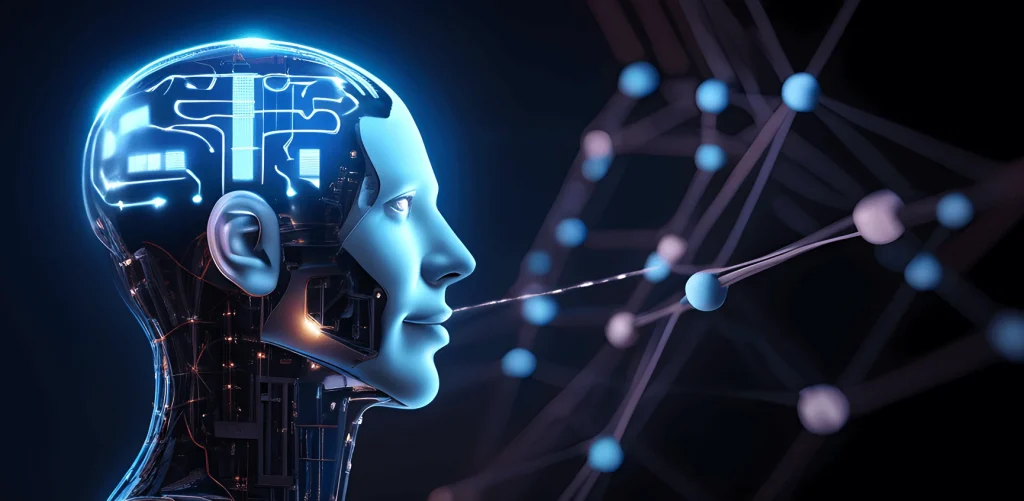In today’s technology-driven era, having foundational knowledge of essential AI concepts is necessary. This article introduces ten crucial terms forming the backbone of the dynamic AI field. Understanding these basics will help you navigate this transformative technology’s rapidly evolving landscape.
Let’s begin with Artificial Intelligence (AI), where machines mimic human intelligence. Machine Learning (ML), a subset of AI, allows systems to learn and improve from data without explicit programming. Deep Learning (DL) focuses on neural networks with many layers.
Next, we have Neural Networks, computational models inspired by the human brain’s structure and function. Natural Language Processing (NLP), Computer Vision, and Reinforcement Learning power various AI applications like speech recognition, image understanding, and decision-making systems.
Lastly, Convolutional Neural Networks (CNNs) handle visual data, and Recurrent Neural Networks (RNNs) work with sequential data. These foundational terms will open doors to a deeper AI understanding.
Machine Learning (ML)
Machine Learning enables computers to learn from data without explicit programming. Machine Learning models identify relationships within data, make predictions, or discover hidden patterns using statistical methods and math, contrasting with traditional computing following coded instructions without data understanding. Instead of predefined operations, Machine Learning can adapt and improve, providing efficient solutions and enhanced decision-making.
What is the function of data in Machine Learning model training?
Data is crucial for a Machine Learning model’s learning process, acting as the fuel enabling pattern recognition and accurate predictions. Like a child observing the world, a model learns from provided data examples. However, models do not possess consciousness; they analyze patterns methodically through mathematical operations like feature extraction, optimization algorithms, and weight adjustments during training. This learning phase results in making predictions or classifications on new, unseen data.
Which Machine Learning algorithms are commonly used and for what purposes?
Here are some popular Machine Learning algorithms:
1. Decision Trees and Random Forests: Decision Trees follow criteria flowcharts for classifying data. Random Forests use ensemble averages of multiple Decision Trees to minimize overfitting.
2. K-Nearest Neighbors: This finds the nearest K neighbors and averages their values to classify new data points.
3. Linear Regression: This finds the line relationship between a feature and dependent variable.
4. Logistic Regression: This introduces a sigmoid function for binary classification problems.
5. Support Vector Machines (SVM): SVMs transform input space to find optimal class separation hyperplanes.
Understanding when to implement each algorithm for different data types, performance optimization, and tailored models is essential.
Neural Networks
Neural networks, like our brain, consist of many connected elements forming intricate relationships. Interconnected computing nodes, or neurons, serve as basic processing units, transmitting and processing information through electrical or mathematical signals. Together, they build complex decision structures to solve problems by recognizing input data patterns and refining performance.
What role do nodes play in neural networks?
Neural networks’ interconnected nodes facilitate information processing by forming communication paths, carrying activation signals between neighboring nodes. These interconnections enable nodes, each with weights, to simulate reasoning by transferring data and refined feature representations at various abstraction levels, mirroring biological neurons’ interconnectivity.
How does a neural network mimic biological neuron function?
Neural networks mimic biological neurons’ functioning. Each artificial neuron receives input signals and determines an output, like biological neurons receiving synaptic potentials. Both sum incoming signals to transmit information. Neural networks employ learning mechanisms that improve performance through experience, altering connection strengths like neural circuits, exhibiting intricate interconnectivity reminiscent of neuron webs communicating through neurotransmitters.
Applications of neural networks with interconnected nodes?
Interconnected nodes in neural networks enable image recognition systems to analyze images and identify shapes by recognizing features from training data. They assist natural language processing applications like speech recognition and translation by understanding and analyzing words, syntax, and grammar. Neural networks are also valuable for forecasting, predictive modeling, and recommendation systems analyzing user preferences and past choices.
In which fields are interconnected node neural networks used?
Interconnected node neural networks are extensively used across various domains, including speech recognition, image processing, natural language processing, predictive modeling, time series prediction, and recommendation systems. The interplay of interconnected nodes brings value to these diverse applications.
How can neural networks be used in different industries with interconnected nodes?
Neural networks’ interconnectivity allows financial institutions to analyze stock price data and identify emerging patterns for profitable suggestions. In healthcare, they can process patients’ medical histories and symptoms for diagnostics and treatment recommendations. Environmental conservation efforts also utilize neural networks to monitor natural disasters, resource consumption, and forecast carbon emissions by processing satellite imagery and climate data.
Reasoning
AI reasoning follows logical sequences, performing deductive and inductive reasoning based on rules and data, excelling at processing large volumes of data to find patterns and provide consistent, precise outputs. Human reasoning uses metaphors, analogies, emotions, common sense knowledge, and creativity, adept at understanding context and nuances, making judgments with incomplete or ambiguous data. The human reasoning process adapts and learns from personal experiences.
Which AI algorithms use reason to make data-driven decisions?
Reasoning and Logical Agents algorithms use inference procedures like deductive and inductive methods to reason from data and derive conclusions. Decision Trees employ recursive feature splitting until adequate decision boundaries form for classification. Rule-Based Systems derive decision rules from examples and human-written rules. Question Answering (QA) Systems retrieve knowledge from text corpora or databases and reason to find suitable answers to queries.
How is reasoning used in real-world applications, with examples like autonomous driving or recommendation systems?
In autonomous driving, vehicles employ reasoning techniques to interpret data from sensors and cameras, understand traffic signs, determine optimal speeds based on conditions, and predict potential hazards. Recommendation systems use reasoning like collaborative filtering and content-based filtering to provide personalized suggestions based on users’ interests, past interactions, and preferences.
Reinforcement Learning
Reinforcement Learning (RL) is a machine learning type where an agent learns to make decisions by interacting with its environment and receiving rewards for certain actions. It differs from supervised learning relying on labeled data, as RL algorithms do not need vast labeled data but learn from relatively few experiences to master complex behaviors through trial and error guided by a reward system.
How does an RL agent learn optimal actions based on maximum reward?
An RL agent learns which actions yield the highest overall reward in a given state through constant evaluation, adapting and adjusting until finding the most efficient path to reach its objectives. It explores its surroundings, receiving positive signals for desirable outcomes and negative ones for undesirable outcomes, improving through trial and error to take optimal actions.
What is a practical application of Reinforcement Learning in the real world?
A classic example is the Q-Learning algorithm demonstrated on Atari games, where a computer learns to play a game like Pong through trial and error, adjusting actions based on resulting higher or lower scores until optimizing its strategy. Reinforcement Learning is also widely adopted in industries like self-driving cars or robotics for manipulating complex objects.
What are the main obstacles in implementing Reinforcement Learning?
Dealing with high-dimensional state and action spaces with countless potential combinations is challenging. Designing proper reward functions to effectively evaluate outcomes is crucial, as misaligned rewards can steer learning incorrectly. Unstable performance when exposed to real-world noises and variations requires extensive fine-tuning across diverse environments.
Long Short-Term Memory (LSTM)
Long Short-Term Memory (LSTM) is a Recurrent Neural Network (RNN) type designed to better handle long-term dependencies in sequential data. Other RNN types struggle with vanishing gradients leading to ineffective learning over long sequences. LSTMs have memory cells utilizing a gating mechanism to control information flow, enabling them to retain important memories for longer durations and mitigate the vanishing gradient problem.
How does Long Short-Term Memory (LSTM) handle long-term dependencies in data?
Traditional RNNs suffer from vanishing and exploding gradient problems when processing sequential data, causing errors during backpropagation to become so small/large that training slows or weights become unstable. LSTM mitigates these challenges through memory cells allowing selective remembering/forgetting of previous information, and gates regulating which information flows to ensure only relevant data propagates further, addressing long-term dependency handling more effectively.
How does LSTM network process data with memory cells for long-term dependencies?
In LSTM networks, memory cells function like a control system determining which input sequence information to keep in memory and when to discard old information. A single cell has gates with weight matrices controlling data flow through transformations.
LSTMs’ ability to maintain relevant context across time stems from these memory cells, allowing the network to retain past data elements while suppressing irrelevant inputs, leading to more accurate extended time series data handling. Through selectively remembering or discarding information based on context, the memory cells enable LSTMs’ exceptional processing abilities for complex, long-term dependencies.
Expanding Your Foundational Knowledge in AI
Understanding these AI terms will help you engage effectively with AI-driven technologies and their impact. Being well-versed in this language will facilitate smoother, more informed communication with colleagues, vendors, and clients.
Grasping basics like neural networks, deep learning, decision trees, random forests, convolutional neural networks, natural language processing, and reinforcement learning is essential. The more knowledgeable you are in these areas, the better equipped you’ll be to harness AI’s power.











Стильные заметки по выбору стильных видов на каждый день.
Мнения экспертов, события, все новинки и шоу.
https://www.palscity.com/read-blog/307226
Pingback: Machado Urges Maduro to Accept Defeat as Protests Sweep Venezuela - Esbecgroup
hey there and thank you for your information – I have certainly picked up
something new from right here. I did however expertise some
technical issues using this web site, as I experienced to reload the site a lot of times previous to I could get it to load properly.
I had been wondering if your web host is OK? Not that
I am complaining, but sluggish loading instances times will often affect your
placement in google and could damage your high quality score if ads and marketing with Adwords.
Anyway I am adding this RSS to my e-mail and could look out for much more of your respective fascinating content.
Make sure you update this again soon.. Escape room